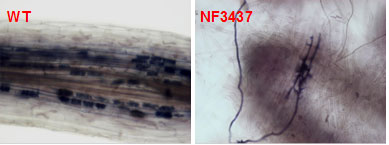The level of AM colonization is tightly regulated by its host and local environment, such as phosphate and nitrogen availability. Some regulation appears to be controlled by the genes which are involved in plant intrinsic developmental programs. In my current research, we am taking genetic approach to study the phenomena. We have isolated two AM specific defected mutants that also show defective growth phenotypes in rice and Medicago. By cloning and analyzing the genes responsible, we will gain insight into the molecular mechanisms of the crosstalk between plant development and mycorrhizal colonization.
Crops, such as wheat, rice and maize, can increase nutrient use efficiency by forming a symbiosis with mycorrhizal fungi in nutrient limited conditions. However in the agro-ecological system, high levels of phosphate suppress mycorrhizal fungus colonization in root, suggesting that symbiotic development is subject to a negative feedback mechanism. It is assumed that the plant host senses its phosphate status, and reacts by suppressing fungal colonization if phosphate supply is not limiting for growth. This phenomenon has raised a number of questions: How is phosphate sensed? How does phosphate sensing impinge on symbiotic development? Does phosphate induce defense reactions against the fungus or is the active symbiotic programme of the plant suppressed by high phosphate levels? To answer these questions, it’s critical to dissect the genetic components which function in regulating mycorrhizal fungi infection and also response to nutrient state, because these genes would be good targets for future genetic engineering of crops with better nutrient use efficiency through symbiotic interactions with soil microorganisms. This research may also deliver important knowledge on how plant sense nutrients state. We are currently focusing on one rice mutant which is more susceptible to nutrient starvation and is also disrupted in the AM symbiosis. This new research direction will shed light on how the plant coordinates its response to nutrient stress with the mycorrhizal symbiosis.

One mycorrhizal defective mutant shows more susceptible to nutrient starvation.
